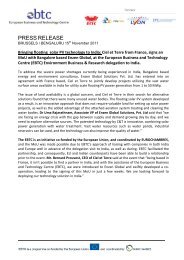Download Report - EBTC
Download Report - EBTC
Download Report - EBTC
You also want an ePaper? Increase the reach of your titles
YUMPU automatically turns print PDFs into web optimized ePapers that Google loves.
36<br />
India-EU: Creating Market Alliances<br />
Trends & Drivers<br />
PPP Models and Favourable Regulations paving the way for Vision 2020 for Wastewater Sector<br />
in India<br />
Key Trends:<br />
Focus of Govt. and<br />
Private Sector<br />
Favorable Economic<br />
and Regulatory Policies<br />
Growing health<br />
conscious population<br />
Need for customisation<br />
Accelerated growth in<br />
Commercial and SME<br />
Sector<br />
Industry moving<br />
towards 100% Reuse<br />
and Recycle<br />
European MNC’s<br />
driving market towards<br />
environmental<br />
compliance<br />
Water requirements of<br />
major water-consuming<br />
industries has grown by<br />
40 times<br />
Agricultural sector uses<br />
85% of the available<br />
fresh water<br />
The Indian wastewater sector has gradually changed in the last<br />
decade. The sector in recent past has seen higher focus from<br />
government agencies and the private sector. Growing population<br />
demands coupled with increasing health consciousness have<br />
fuelled the growth in the Indian wastewater sector.<br />
Water and wastewater treatment, especially in the industrial and<br />
municipal sectors, is becoming big business. The point-ofconsumption<br />
market that involves localised treatment of water by<br />
setting up distribution channels is ~€ 166M. Industries in the<br />
country require normal to ultra-purified market (as with<br />
pharmaceutical companies) and this segment has business to the<br />
tune of € 332M, growing at 15% annually.<br />
The real growth for the sector will come from the municipal water<br />
and wastewater treatment business, mainly dependent on<br />
government allocations and funds from agencies such as Asian<br />
Development Bank, World Bank, JNNURM and JBIC.<br />
Customisation is just one of the many options available that can<br />
be selected in view of pressing factors such as a general space<br />
crunch that bothers many industrial and commercial SMEs, while<br />
setting up an effluent plant. The accelerated growth seen in<br />
commercial sector (hotels, hospitals, institutions, shopping malls)<br />
and small and medium scale industries (food and beverages,<br />
sugar, chemicals, pharmaceuticals) has imparted thrust into this<br />
market.<br />
Due to the pattern of industrial development and the undeniable<br />
achievement of the commercial sector, state governments are<br />
drafting specific economic and regulatory policies to attract<br />
industrial and Information Technology investments.<br />
The highlights of the wastewater management sector in India are<br />
as follows:<br />
Fragmented Market: More than 500 companies, of which<br />
around 20 are large and the rest are small<br />
Unorganised Market: Major part of wastewater treatment and<br />
services market in rural India is unorganised, not regulated and<br />
there is little involvement of municipal bodies to enforce law<br />
Suite of Solutions: Apart from the supply of the equipments,<br />
companies are also profiting themselves by providing<br />
consulting and design services to the Indian water industry<br />
Initiatives: Major Initiates are taking-off by GOI / Pvt. Sector,<br />
also more and more ULBs are approaching capital markets<br />
Reference: Dr. D. D. Basu, Sr. Scientist, CPCB<br />
www.ebtc.eu















